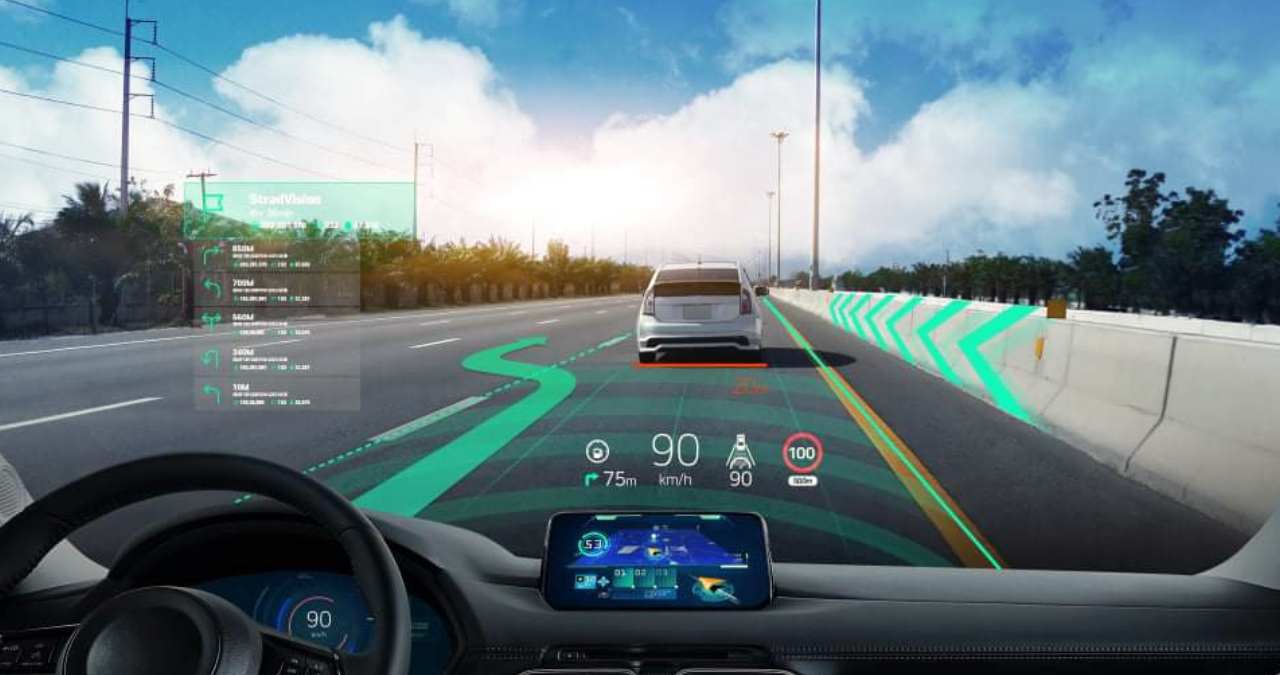Unlike earlier automotive head-up windshield displays that provided limited information on vehicle speed or GPS information, StradVision’s augmented reality head-up display (AR HUD) adds much more information gathered from sensors in real-time for Advanced Driver Assistance System (ADAS) warnings, increasing driver eyes-on-the-road benefits.
Since the introduction of AR HUD in 1988, many OEMs have been incorporating the technology in their vehicle lineups, with the expectation that it might become a standard feature in coming years.
Table of Contents
Advances Since Earlier HUD Systems
Legacy HUD provides only limited information on vehicle driving conditions such as speed and RPM, and the display area is also small, making it difficult to sufficiently occupy the driver’s field of vision in actual driving situations. In addition, the navigation information guides the vehicle’s driving route using arrows sequentially displayed, which frequently confuses the driver.
Unlike legacy ones, this next-generation HUD places computer graphics that interact with the driver’s field of vision, allowing critical information to be overlaid directly onto the actual road. Furthermore, this is implemented in a form that the driver’s field of vision is naturally expanded, which greatly improves situational awareness.
AR HUD Will Increase Driver Safety
AR HUDs must process vast amounts of data from the road environment in real-time to project information that the driver can intuitively perceive. This requires complex computing technology to analyze the acquired data rapidly and integrate it with real-world objects accurately. However, contrary to these difficult technical efforts to implement AR HUD, this innovative solution brings the benefits of precise recognition to drivers, which translates into a safe driving experience beyond convenience.
These technical benefits become clearer in the integration with ADAS alerts. Currently, most ADAS alerts are primarily indicated by flashing symbols or audible alerts. This method requires the driver to learn the signals of various ADAS alerts in advance and recognize and interpret them in real situations. This causes unnecessary delays in real-world driving where situational awareness and judgment must be made within few seconds.
However, AR HUDs can identify threats by displaying them directly within the driver’s line of sight. In addition, AR graphics are overlaid on real objects in such a way that the driver can immediately recognize the threat and quickly take appropriate action, such as braking against road obstacles. Displaying ADAS warnings in this way significantly improves the driver’s reaction time and situational awareness, especially during night driving or in low-visibility conditions.
Soon To Come Into Our Daily Lives
Our driving environment is getting faster and more complex. Now, AR HUD is no longer just an option to show off the technological prowess of an automaker or the luxury of a vehicle. The increase in vehicles and pedestrians and our complex lifestyles force drivers to perceive more objects and information on the road and react to more unpredictable situations. AR HUD will soon become an integral part of our driving experience, and we believe it will make a significant contribution to the safety of drivers and pedestrians.
About StradVision Inc.
Founded in 2014, StradVision is an automotive industry pioneer in AI-based vision processing technology for Advanced Driver Assistance Systems (ADAS). The corporate is accelerating the arrival of fully autonomous vehicles by making ADAS features available at a fraction of the market cost compared with competitors. StradVision’s SVNet is being deployed on 50+ vehicle models in partnership with 9 OEMs and powers 13 million ADAS & Autonomous Vehicles worldwide and is serviced by over 170 employees in Seoul, San Jose, Tokyo, and Munich. the corporate received the 2020 Autonomous Vehicle Technology ACES Award in Autonomy (Software Category). Additionally, StradVision’s software is certified to the ISO 9001:2015 international standard.
Also Read: Update IT Infrastructure For AI What Resources Must Be Optimized
